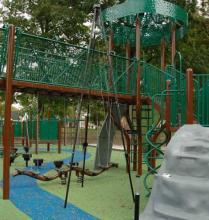
Head Injury Criteria is a measurement of the time duration of head deceleration during impact. A mathematical formula is used to derive a value known as Head Injury Criteria or HIC. The value of HIC with regard to the impact on a playground surface may not be more than 1000.1
This concept is important because head injuries are the most serious type of playground injuries. They are most frequently caused by a fall to the surface. Most recorded playground fall-related deaths involved head injury.2 Children under the age of 4 are the most likely to suffer head injuries.3
The testing for HIC on playground surfaces is done by using a Triax 2000 surface testing instrument. The Triax measures both the force of impact and the duration of deceleration during impact to be sure that the surface material being tested meets the specifications for impact attenuation of playground surfacing found in the ASTM F1292 standard, “Standard Specification for Impact Attenuation of Surfacing Materials Within the Use Zone of Playground Equipment.” The specifications are that to reduce the severity of head injury, the force of the impact must be less than 200 G’s and the time of deceleration must be less than 1000.4
The relationship between the impact magnitude and the risk of head injury is based on research done for automotive and aircraft safety.5
Surfaces such as grass, dirt, and asphalt do not have impact absorbing characteristics and are not considered safe for playground use. Engineered wood fiber, shredded rubber, poured in place rubber, and rubber mats are considered safe surfaces if they are the proper depth in relation to the height of the play equipment. Manufacturers of compliant playground surfacing can provide certification that the depth of the surface recommended for playground use is appropriate for a particular playground installation.
- 1. ASTM International (ASTM) Standard F 1292-13, “Standard Specification for Impact Attenuation of Surfacing Materials Within the Use Zone of Playground Equipment,” 4.2, p. 4.
- 2. CPSC Special Study, Tinsworth and McDonald, “Injuries and Deaths Associated with Children’s Playground Equipment,” p. 25.
- 3. National Safe Kids Campaign (NSKC), “Playground Injury Fact Sheet.” Washington (DC): NSKC, 2004.
- 4. Skulski, Jennifer K. “City of Detroit Sets Strict Specs to Ensure New Playground Surfaces are Safe and Accessible.” < http://www.ncaonline.org/making-the-grade/detroit.shtml > 9 April 2012.
- 5. Op. Cit. ASTM F 1292-13, Appendix X1, p. 17.

